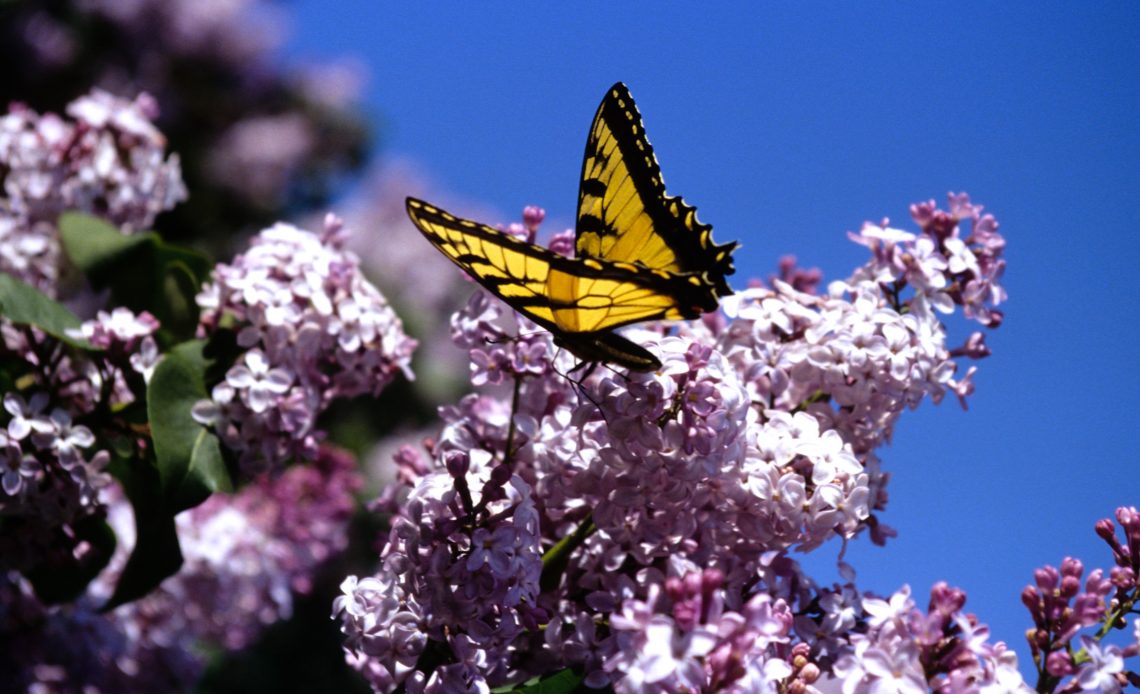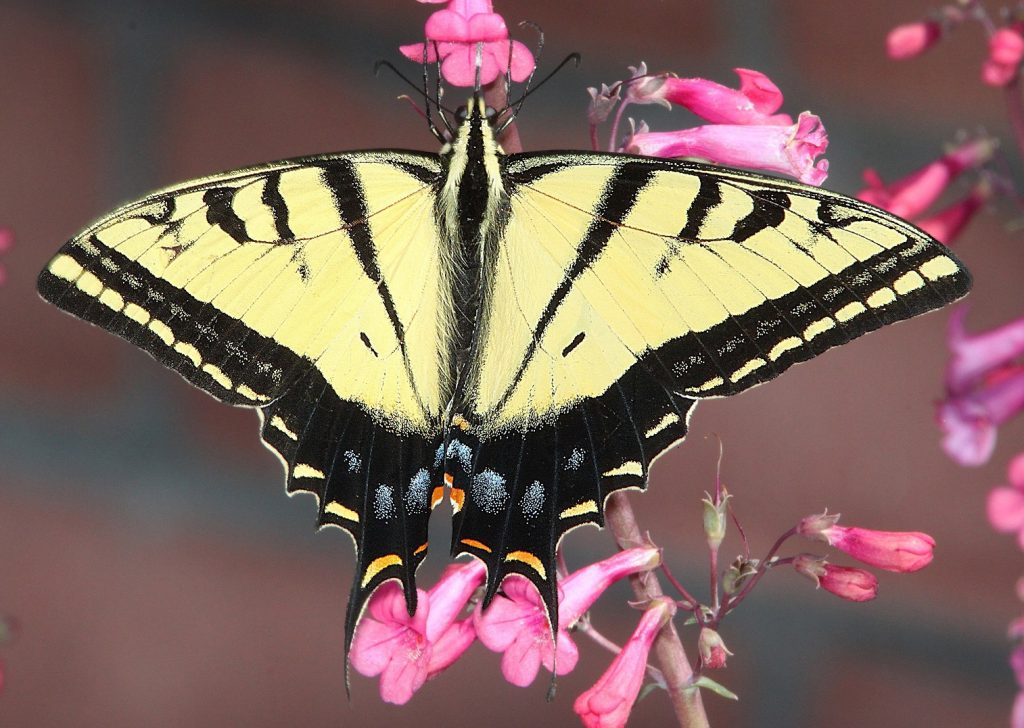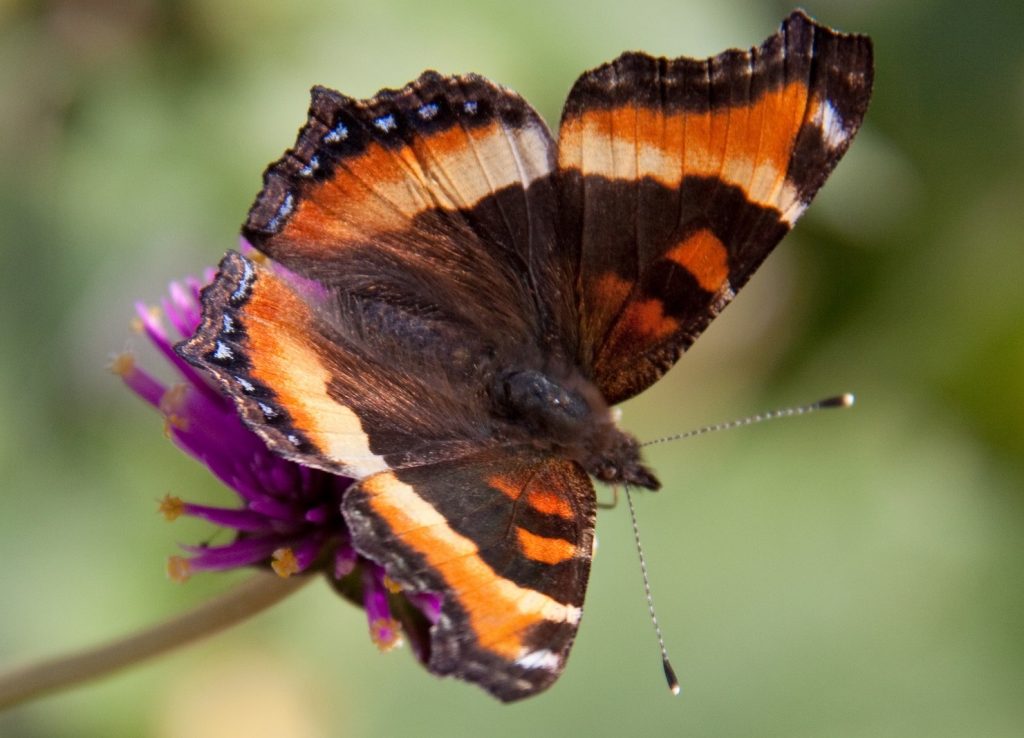

We’re here to help! Wild Yards is a completely free website that is 100% dedicated to helping you create a wildlife-friendly, sustainable yard. Read more
WildYards is reader-supported. When you buy a product through a link on our site, we may earn a comission. Every product is independently selected by our (obsessive) editors and our reviews are unbiased and objective. Read more about our mission or our privacy policy.
Fragrant lilacs and colorful butterflies – could there be any lovelier and more evocative image of a summer garden? The heady scent, purple blossoms, and delicate, fluttering wings make for a stunning sight. But is this what you can expect when planting a lilac bush in your wild yard? Do butterflies like lilacs?
Butterflies love lilacs. They are considered, along with butterfly bush and hydrangeas, one of the shrubs most loved by butterflies. The color, fragrance, and arrangement of the blossoms all make lilacs great shrubs for feeding butterflies. Planting a lilac bush in your yard is a wonderful way to attract more butterflies to your garden.
Are lilacs and butterfly bushes the same?
First, let’s talk about what a lilac is, because you might be confused at this point. There are two very similar, purple-flowered bushes that are commonly found in gardens, both of which are called “lilac”.
The common, or French lilac (Syringa vulgaris) is the true lilac for which the shade of purple is named, and has been cultivated ornamentally since the 16th century. It is native to southeast Europe but has become naturalized in Asia and North America.
The other shrub is nicknamed “summer lilac” and produces similar spikes of small, purple flowers. The proper name for this bush is buddleia, and it’s also sometimes called “butterfly bush”. It is a much more recent addition to domestic gardens and is native to East Asia. Buddleias are becoming increasingly popular, but they’ve also become invasive in many areas.
While they look similar, these two bushes are completely different species; buddleias are members of the figwort family, while true lilacs are related to olives. For this article, we are strictly talking about the common lilac.
What kinds of animals are attracted to lilac?
Lilac is attractive to many different pollinators, not just butterflies. The fragrant, purple flowers of the common lilac are visited by many different insect species, including honey bees and moths.
Perhaps because they are native to an area without hummingbirds, these jewel-bright little pollinators don’t seem to care for lilac much. Many other shrubs attract hummingbirds, however.
And of course, multiple different species of butterflies are drawn to lilac bushes. Some of the most common species you might see visiting your lilac bush are:
The two-tailed swallowtail: A large yellow and black butterfly with orange eyespots on its hindwings. Two-tailed swallowtails are drawn to purple flowers as nectar plants, including thistles, milkweeds, and of course, lilacs.

Milbert’s tortoiseshell, also called the fire-rim tortoiseshell: A brown butterfly with striking, orange-rimmed wings. These tortoiseshells not only love lilacs but also enjoy the sweet taste of overripe fruit. Try leaving out overripe oranges or bananas to attract these butterflies.

And of course, the beautiful and increasingly endangered monarch butterfly enjoys using lilac as a nectar plant. Monarchs use milkweed as a host plant, a plant on which they lay their eggs and on which the caterpillars will feed. Many other species of butterfly, including the two-tailed swallowtail, use milkweed as a nectar plant. So planting milkweed along with your lilacs is sure to bring even more species of butterfly to your wild yard!
Do caterpillars like lilac?
One of the reasons that lilacs are so popular amongst gardeners is that they are very resistant to both diseases and pests. As such, butterflies do not tend to use lilacs as a host plant.
The only member of the butterfly family that lays its eggs on lilacs is the ash-borer moth, also known as the lilac-ash borer. The larva of these clearwing moths feeds on the greenwood beneath the lilac’s bark and can be deadly to the shrub.
You might have noticed small, circular sections cut from your lilac’s leaves and are wondering what kind of caterpillar you have. The answer is no caterpillar at all! Your lilac is likely being visited by leafcutter bees. Leafcutters use these circular-cut leaf sections to build their nests and are very fond of lilacs.
Don’t worry, as long as the bush isn’t overloaded with bees, the leafcutters won’t harm it, and the bees are also valuable pollinators.
How do you grow lilacs?
Lilacs have persisted in gardens for so long not just because they’re beautiful, they’re also remarkably easy to grow!
Young shrubs can be easily purchased at most nurseries or garden centers and should be planted out in spring or fall. Plant it where it can enjoy the full sunshine, and try to find a place where it won’t get too wet. Lilacs are prone to root rot, so make sure the soil has good drainage.
If you’re forced to plant your lilac in heavy clay, you can add large amounts of mulch around the bush’s roots to help with drainage. Lilacs prefer neutral or slightly alkaline soil.
Lilacs are loners; they don’t do well in crowds! Make sure your lilac has a portion of the garden all to itself, at least six feet away from other trees. It needs the space! Most lilacs can get up to fourteen feet in height.
Once a lilac bush is established, it needs very little maintenance, save for some fertilizer once a year and occasional watering during particularly hot weather. Deadhead the flowers to increase the blooming season. Once your shrub is mature (five or six years old), give it a quick prune every year once it has finished flowering to remove any dead branches. Don’t prune too early, however, or you’ll spoil the year’s flower crop!
Lilacs tend to bloom early, around late spring through early summer, and this short blooming season is one of the few disadvantages. However, some cultivars and domestic hybrids, such as the popular Boomerang variety, will have a second blooming season in early fall. This makes them even more valuable to butterflies; late-emerging butterflies, or migratory species like the monarch as they will treasure anything that blooms in the fall.
Lilacs do best in USDA hardiness zones 5 through 7; they tolerate cold well and need frost to help set next year’s blossoms. Some recently developed cultivars, however, have adapted to warmer climates and can thrive through zone 9.
What is the best shrub to attract butterflies?
There really is no “best shrub”; so many different shrubs are loved by butterflies for all kinds of different reasons. But lilacs are most definitely high on the list!
With their tight clusters of scented, purple flowers, lilacs seem tailor-made for butterflies, and new cultivars with longer or repeated blooming seasons have made them even better. If you live in a cooler climate and have a large empty corner in your butterfly garden, a lilac might be just what you’re looking for.
